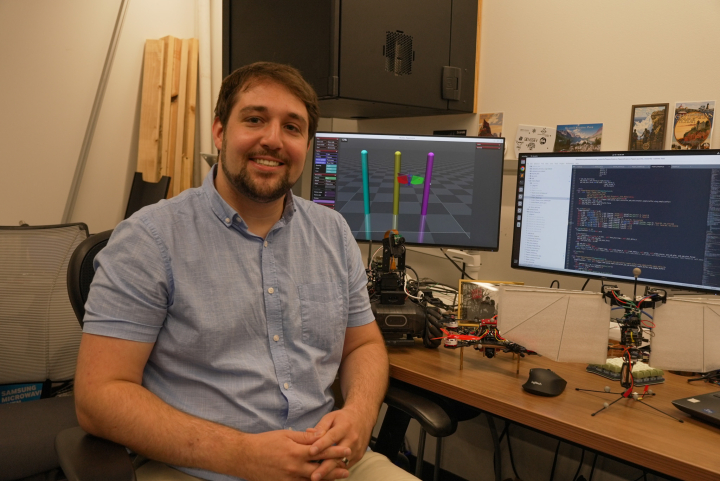Graduate Student Balances Research, Service and Mentoring
Tiny autonomous drones designed to mimic and support bee populations. Larger drones that can navigate difficult terrain with the agility of a hummingbird. Robots that learn to cookby watching YouTube videos.
These projects, and many more, were conceived, developed and tested by the University of Maryland’s Perception and Robotics Group, co-led by Yiannis Aloimonos, a professor of computer science, and Cornelia Fermüller, a research scientist in the University of Maryland Institute for Advanced Computer Studies (UMIACS).
A common thread in much of the group’s work is the ability to build computational systems that can mimic human or insect behavior with stunning accuracy.
Another thread is the vibrant cluster of graduate students populating the lab, currently numbering 25, with one of the senior students often serving as a lab manager responsible for supporting the group’s day-to-day-activities.
The latest student to take the mantle as lab manager is Levi Burner, a sixth-year doctoral candidate in electrical and computer engineering.
Burner, who is co-advised by Aloimonos and Fermüller, says his role is threefold: helping coordinate and manage activities in the lab, providing mentorship to new students, and conducting his own research that combines expertise in computer vision with novel algorithms that can mirror human cognitive behavior.
Aloimonos, who also has an appointment in UMIACS, says his personal preference is to never formally appoint a lab manager. Instead, he and Fermüller like to have one of their graduate students take the initiative and work their way into the role.
“At big universities, things happen, and people step in,” Aloimonos explains. “That’s exactly what happened with Levi. He joined the lab and was bringing skills and capabilities other students did not have.”
Burner’s research is currently focused on what he and his lab mates refer to as “embodied visuomotor representation.” It mimics how a person may not know the exact distance an object is from their body when reaching for it, but they can comfortably grab it because they’re aware of how far they can reach.
Click HERE to read the full article
The Department welcomes comments, suggestions and corrections. Send email to editor [-at-] cs [dot] umd [dot] edu.
